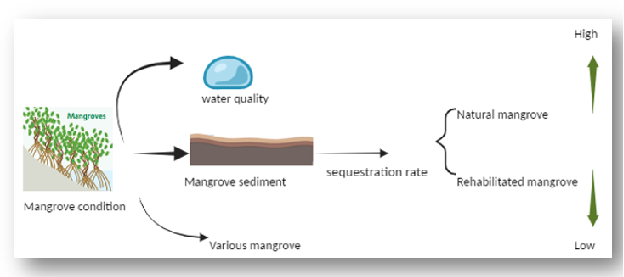Document Type : SHORT COMMUNICATION
Authors
1 Research Center for Oceanography, National Research and Innovation Agency, Jakarta, Indonesia
2 Department of Marine Science, Faculty of Fisheries and Marine Science, Diponegoro University, Tembalang, Semarang, Central Java, 50275, Indonesia
Abstract
BACKGROUND AND OBJECTIVES: A major function of mangroves is carbon sequestration in sediment. This study aimed to determine differences in carbon content in sediments in various types of mangroves and environmental parameters.
METHODS: This study was carried out in Pesawaran as a natural mangrove and in South Lampung as rehabilitated mangrove in Indonesia. Purposive sampling method was used by considering the types of mangroves at the locations. Sediment sampling was taken using a polyvinyl chloride pipe with a diameter of 47.46 milimeters and a height of 30 centimeters. The sediment parameters measured were bulk density, carbon stock, and sequestration. Environmental parameters measured included sediment texture, potential of hydrogen, temperature, salinity, and total dissolved solids. A statistical analysis was conducted using the principal component analysis to determine the relationship between the organic carbon stock and the environmental parameters.
FINDINGS: The study results showed that natural mangroves (Pesawaran) had a higher organic carbon value at 2.2 ± 0.32 percent than rehabilitated mangroves (South Lampung) at 0.9 ± 0.25 percent. The principal component analysis results revealed that organic carbon, carbon dioxide equivalent, carbon stock, and carbon sequestration had positive correlation characteristics influenced by salinity, silt, and clay, while negative correlation characteristics were affected by temperature, total dissolved solids, and sand. The distribution of sediment texture tended to show more silt in rehabilitated mangroves, while natural mangroves tended to have the same composition between sand and silt. The potential of hydrogen conditions in natural and rehabilitated mangroves showed no significant differences in values. The salinity in Pesawaran, which was classified as a natural mangrove, was higher due to the influence of the tides and was directly facing the shoreline. Meanwhile, in South Lampung, which was categorized as a rehabilitated mangrove, the salinity was lower due to the long dry season and the canals being unable to support the water entering the mangroves.
CONCLUSION: The organic carbon content at the research locations was influenced by the older age of the Rhizophora stylosa compared to that of the Rhizophora mucronata and Ceriop tagal types of mangroves. The carbon sequestration rate values showed 1.65–3.14 for natural mangroves and 0.29–1.25 for rehabilitated mangroves, thus establishing that the rate is higher (2–3 times) in natural mangroves than in rehabilitated mangroves.
Graphical Abstract
Highlights
- The older age of Rhizophora stylosa compared to that of the two other types of mangroves, Rhizophora mucronata and Ceriop tagal, influenced the OC content at the study locations;
- High clay texture had an impact on high SOC content compared to low clay texture;
- The SOC relationship was influenced by pH; for example, a higher SOC value resulted in a higher pH and vice versa;
- Silt texture is found in dominant natural mangroves and rehabilitated mangroves.
Keywords
Main Subjects
OPEN ACCESS
©2024 The author(s). This article is licensed under a Creative Commons Attribution 4.0 International License, which permits use, sharing, adaptation, distribution and reproduction in any medium or format, as long as you give appropriate credit to the original author(s) and the source, provide a link to the Creative Commons license, and indicate if changes were made. The images or other third party material in this article are included in the article’s Creative Commons license, unless indicated otherwise in a credit line to the material. If material is not included in the article’s Creative Commons license and your intended use is not permitted by statutory regulation or exceeds the permitted use, you will need to obtain permission directly from the copyright holder. To view a copy of this license, visit:
http://creativecommons.org/licenses/by/4.0/
PUBLISHER NOTE
GJESM Publisher remains neutral concerning jurisdictional claims in published maps and institutional affiliations.
CITATION METRICS & CAPTURES
Google Scholar | Scopus | Web of Science | PlumX Metrics | Altmetrics | Mendeley |
CURRENT PUBLISHER



Letters to Editor
[1] Letters that include statements of statistics, facts, research, or theories should include appropriate references, although more than three are discouraged.
[2] Letters that are personal attacks on an author rather than thoughtful criticism of the author’s ideas will not be considered for publication.
[3] Letters can be no more than 300 words in length.
[4] Letter writers should include a statement at the beginning of the letter stating that it is being submitted either for publication or not.
[5] Anonymous letters will not be considered.
[6] Letter writers must include their city and state of residence or work.
[7] Letters will be edited for clarity and length.
Send comment about this article